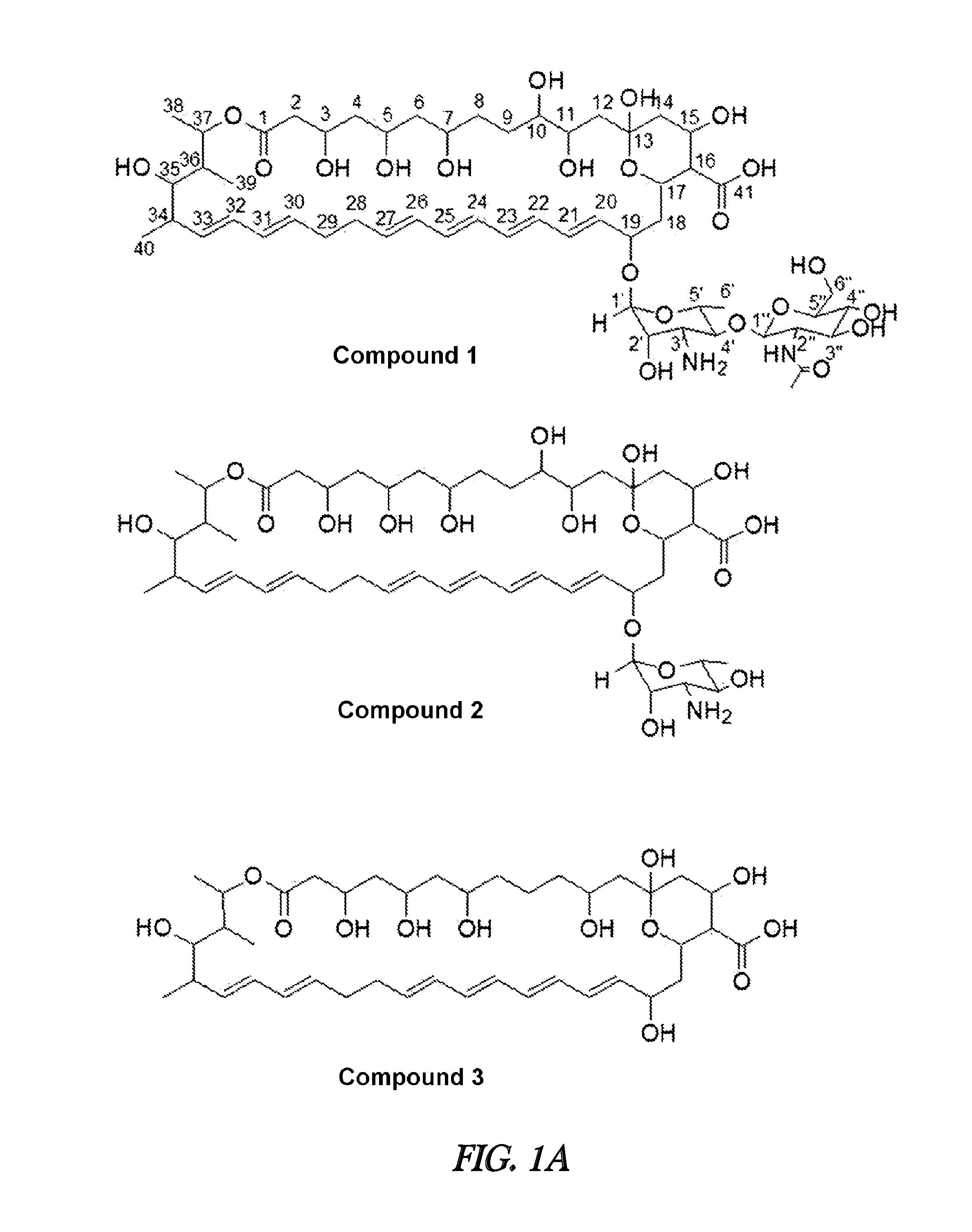Novel polyene compound, method for preparing the same, and antifungal drug comprising novel polyene compound asactive ingredient
a polyene compound and antifungal technology, applied in the field of new polyene compound, method for preparing the same, and novel polyene compound asactive ingredient, can solve the problems of compound not meeting the treatment of systemic fungal infection as a whole, compound death of fungal cells, and troublesome disease treatment, etc., to achieve low cytotoxicity, maintain antifungal activity, and solubility
- Summary
- Abstract
- Description
- Claims
- Application Information
AI Technical Summary
Benefits of technology
Problems solved by technology
Method used
Image
Examples
example 2
Construction of nppDI Deletion Mutant
[0067]Pseudonocardia autotrophica ESK601
[0068]The nppDI gene was disrupted by pKC1139-mediated double crossover recombination. A 2.3 kb BamHI / SpeI fragment, including the nppDI upstream region, was PCR amplified from P. autotrophica genomic DNA using the oligonucleotides DI.N.F and DI.N.R. A 1.5 kb SpeI / KpnI fragment, including the nppDI downstream region, was PCR amplified from P. autotrophica genomic DNA using the oligonucleotides DI.A.F and DI.A.R. The two resulting PCR products were cloned individually in the T&A cloning vector (RBC), further excised from the resulting constructs with BamHI / SpeI and SpeI / KpnI, respectively, and ligated, with the 7.5 kb BamHI / KpnI fragment from pKC1139-tsr, yielding plasmid pMJDI for the in-frame deletion of nppDI (FIG. 2a).
[0069]The pMJDI was first introduced into E. coli ET12567 / pUZ8002 via electroporation, followed by introduction into P. autotrophica KCTC9441 by conjugation. After incubation at 28° C. for ...
example 3
Construction of Plasmids pMJPDI and pMJYDI for the Complementation of the nppDI Deletion Mutant ESK601
[0070]A 1578 by fragment encompassing the nppDI coding sequence was PCR amplified from P. autotrophica genomic DNA with the oligonucleotides PDI.comp.F and PDI.comp.R. The PCR product was cloned in the RBC T&A cloning vector, sequenced, further excised from the resulting construct as BglII / XbaI fragment, and ligated into the BamHI / XbaI sites of the integrative vector ermE*pSET152, yielding plasmid pMJPDI. A 1658 by fragment containing the nysDI coding sequence was PCR amplified from S. noursei genomic DNA using YDI.comp.F and YDI.comp.R. The obtained PCR product was cloned in the RBC T&A cloning vector, sequenced, further excised from the resulting construct as BamHI / XbaI fragment, and ligated into the BamHI / XbaI sites of the integrative vector ermE*pSET152, yielding plasmid pMJYDI. The resulting recombinant plasmids were introduced into the P. autotrophica ESK601 mutant strain indi...
example 4
Construction of NppC PKS ER Domain Deletion Mutant Pseudonocardia autotrophica ESK604
[0071]To delete the ER5 domain of the NppC PKS by pKC1139-based double homologous recombination, the ER5 domain in-frame deletion plasmid pMJC was prepared by the same manner as described in Example 2, by which exconjugants were selected (FIG. 4a). DNA was extracted therefrom, followed by PCR amplification by using the pair of ER5.checkF-ER5.checkR (FIG. 4b).
PUM
| Property | Measurement | Unit |
|---|---|---|
| concentration | aaaaa | aaaaa |
| volume | aaaaa | aaaaa |
| size | aaaaa | aaaaa |
Abstract
Description
Claims
Application Information
 Login to View More
Login to View More - R&D
- Intellectual Property
- Life Sciences
- Materials
- Tech Scout
- Unparalleled Data Quality
- Higher Quality Content
- 60% Fewer Hallucinations
Browse by: Latest US Patents, China's latest patents, Technical Efficacy Thesaurus, Application Domain, Technology Topic, Popular Technical Reports.
© 2025 PatSnap. All rights reserved.Legal|Privacy policy|Modern Slavery Act Transparency Statement|Sitemap|About US| Contact US: help@patsnap.com



